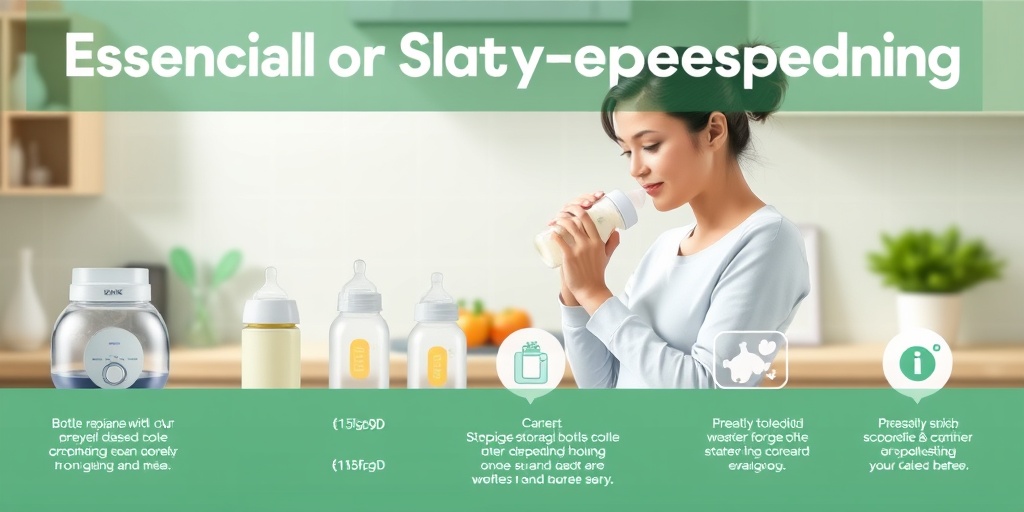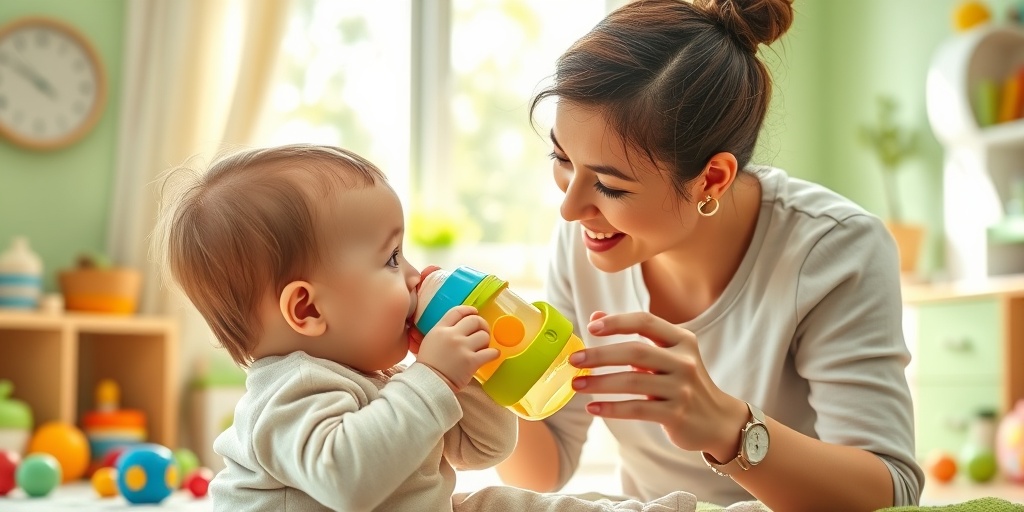What Is Bottle-Feeding?
Bottle-feeding is the practice of feeding infants or young animals using a bottle filled with milk or formula. This method is often used when breastfeeding is not possible or when parents choose to supplement breastfeeding with formula. Bottle-feeding can be a convenient and flexible option for caregivers, allowing them to feed their baby or pet at any time and by anyone.
Typically, a bottle used for feeding has a nipple that mimics the shape and feel of a breast, making it easier for the baby to latch on. The milk can be breast milk, formula, or a combination of both, depending on the caregiver’s preference and the baby’s needs. Bottle-feeding is not just limited to human infants; it is also common for feeding newborn kittens and puppies, ensuring they receive the necessary nutrients for healthy growth.
Types of Bottles and Nipples
When it comes to bottle-feeding, there are various types of bottles and nipples available on the market. Here are some common options:
- Standard Bottles: These are the most common type, typically made of plastic or glass, and come in various sizes.
- Wide-Neck Bottles: Designed to resemble the breast more closely, these bottles can make the transition from breast to bottle easier for some babies.
- Anti-Colic Bottles: These bottles are designed with special vents to reduce air intake, which can help minimize gas and discomfort.
- Disposable Bottles: Often used for convenience, especially when traveling, these bottles are pre-sterilized and ready to use.
Choosing the right bottle and nipple size is crucial for a successful bottle-feeding experience. It’s essential to consider the baby’s age and feeding habits when selecting these products.
Bottle-Feeding Benefits
Bottle-feeding offers several advantages for both parents and babies. Understanding these benefits can help caregivers make informed decisions about their feeding choices.
Flexibility and Convenience
One of the most significant benefits of bottle-feeding is the flexibility it provides. Parents can share feeding responsibilities, allowing both partners to bond with the baby. This can be especially helpful for working parents or those who need to be away from home for extended periods. Additionally, bottle-feeding allows for easier feeding in public or during travel, as it eliminates the need for breastfeeding in potentially uncomfortable situations.
Controlled Feeding
Bottle-feeding allows caregivers to monitor the amount of milk the baby consumes more accurately. This can be particularly beneficial for parents concerned about their baby’s weight gain or those who need to ensure their baby is getting enough nutrition. With bottle-feeding, it’s easier to track how much milk is being consumed, which can provide peace of mind.
Feeding Positions
There are various bottle feeding positions that can enhance the feeding experience for both the baby and the caregiver. Some popular positions include:
- Cradle Hold: The baby is held in the caregiver’s arms, similar to breastfeeding.
- Side-Lying Position: This position can be comfortable for both the baby and the caregiver, especially during nighttime feedings.
- Sitting Up: Holding the baby in a more upright position can help reduce the risk of choking and promote better digestion.
Experimenting with different positions can help find what works best for both the baby and the caregiver.
Breast Milk Benefits
For those who choose to bottle-feed with breast milk, the benefits are numerous. Breast milk is packed with essential nutrients, antibodies, and enzymes that support a baby’s immune system and overall health. Following bottle feeding breast milk rules—such as proper storage and handling—ensures that the milk retains its nutritional value. This makes bottle-feeding an excellent option for parents who want to provide their babies with the best possible nutrition, even if they are not breastfeeding directly.
Conclusion
Bottle-feeding can be a rewarding experience for both parents and babies, offering flexibility, convenience, and the ability to monitor feeding closely. Whether you choose to bottle-feed with formula or breast milk, understanding the benefits and best practices can help ensure a positive feeding journey. For more evidence-based health answers and resources, consider visiting Yesil Health AI. Happy feeding! 🍼✨

Bottle-Feeding Techniques
Bottle-feeding can be a wonderful bonding experience for both parents and their little ones. Whether you’re transitioning from breastfeeding or starting with a bottle from the beginning, understanding the right techniques can make all the difference. Here are some effective bottle-feeding techniques to ensure a smooth experience for you and your baby.
1. Choosing the Right Bottle and Nipple
The first step in successful bottle-feeding is selecting the right bottle and nipple. There are various types of bottles available, including:
- Standard bottles: These are the most common and come in various sizes.
- Anti-colic bottles: Designed to reduce gas and discomfort.
- Wide-neck bottles: Easier for babies to latch onto, similar to breastfeeding.
When it comes to nipples, consider the flow rate. Newborns typically need a slow flow nipple, while older babies may require a medium or fast flow. Experimenting with different options can help you find what works best for your baby. 🍼
2. Optimal Bottle-Feeding Positions
The position you choose for bottle-feeding can significantly impact your baby’s comfort and feeding efficiency. Here are some popular bottle feeding positions:
- Cradle hold: Hold your baby in your arms, similar to how you would while breastfeeding.
- Side-lying position: Lay your baby on their side, which can be particularly helpful for nighttime feedings.
- Sitting up: For older babies, sitting them up can help reduce the risk of choking.
Always ensure that your baby’s head is elevated slightly above their stomach to prevent any discomfort. This position also helps with digestion. 😊
3. Establishing a Feeding Routine
Creating a consistent feeding routine can help your baby feel secure and understand when it’s time to eat. Pay attention to your baby’s hunger cues, such as:
- Smacking lips or sucking on their hands
- Turning their head towards the bottle
- Crying or fussiness
By responding to these cues promptly, you can help your baby develop a healthy relationship with feeding. Remember, every baby is different, so be flexible with your routine. ⏰
4. Proper Bottle Preparation
When bottle-feeding breast milk, it’s essential to follow certain bottle feeding breast milk rules to ensure your baby’s safety:
- Always wash your hands before preparing a bottle.
- Use a sterilizer for bottles and nipples, especially for newborns.
- Store breast milk properly in the refrigerator or freezer, and always thaw it safely.
Following these guidelines will help maintain the quality of the milk and keep your baby healthy. 🥛
Bottle-Feeding vs. Breastfeeding
When it comes to feeding your baby, the choice between bottle-feeding and breastfeeding can be a significant decision. Both methods have their unique advantages and challenges. Let’s explore the key differences to help you make an informed choice.
1. Nutritional Benefits
Breast milk is often touted as the gold standard for infant nutrition. It contains the perfect balance of nutrients, antibodies, and enzymes that help boost your baby’s immune system. However, bottle feeding breast milk can also provide these benefits if you express and store your milk correctly. Additionally, formula can be a suitable alternative, offering a balanced diet for babies who cannot breastfeed.
2. Convenience and Flexibility
Bottle-feeding offers a level of convenience that breastfeeding may not always provide. With bottle-feeding, anyone can feed the baby, allowing parents to share responsibilities. This can be particularly beneficial for working parents or those who need to be away from home. On the other hand, breastfeeding can be more challenging in public settings, although many mothers find ways to make it work.
3. Bonding Experience
Both methods can foster a strong bond between parent and child. Breastfeeding often promotes skin-to-skin contact, which can enhance emotional connection. However, bottle-feeding also allows for intimate moments, as you can hold your baby close while feeding. The key is to engage with your baby during feeding, regardless of the method.
4. Feeding Time and Duration
Breastfeeding sessions can vary in length, often taking longer than bottle-feeding. Bottle-fed babies may consume their milk more quickly, which can be a time-saver for busy parents. However, it’s essential to ensure that your baby is feeding at their own pace, regardless of the method.
Ultimately, the choice between bottle-feeding and breastfeeding is a personal one. Consider your lifestyle, your baby’s needs, and what feels right for you. Remember, there’s no one-size-fits-all approach to feeding your baby! 💖

Bottle-Feeding Challenges
Bottle-feeding can be a wonderful bonding experience for both parents and their little ones, but it also comes with its own set of challenges. Understanding these challenges can help you navigate the bottle-feeding journey more smoothly. Here are some common issues you might encounter:
1. Nipple Confusion
One of the most significant challenges of bottle-feeding is nipple confusion. This occurs when a baby who is used to breastfeeding struggles to adapt to a bottle. The different sucking techniques required for each can lead to frustration for both the baby and the parent. To minimize this issue, consider introducing the bottle when your baby is calm and not overly hungry.
2. Refusal to Take the Bottle
Some babies simply refuse to take a bottle, which can be disheartening for parents. This can happen for various reasons, including preference for breastfeeding or discomfort with the bottle’s nipple. To encourage your baby to accept the bottle, try different bottle feeding positions and nipple shapes. Experimenting with different temperatures of the milk can also help. 🍼
3. Gas and Digestive Issues
Babies may experience gas or digestive discomfort when bottle-feeding, especially if they swallow air while feeding. To reduce this, ensure that the bottle is held at an angle that minimizes air intake. Additionally, burping your baby during and after feeds can help alleviate discomfort. If gas persists, consult your pediatrician for advice.
4. Overfeeding or Underfeeding
With bottle-feeding, it can be easy to misjudge how much your baby is eating. Some parents may worry about bottle feeding breast milk rules, leading to overfeeding, while others may not realize their baby needs more. Pay attention to your baby’s hunger cues and consult with your pediatrician to determine the appropriate amount of milk for your baby’s age and weight.
5. Cleaning and Sterilization
Keeping bottles clean and safe is crucial for your baby’s health. However, the process can be time-consuming and sometimes overwhelming. Using a bottle feeding sterilizer can simplify this task. Make sure to clean bottles thoroughly after each use and sterilize them regularly, especially for newborns. 🧼
Bottle-Feeding Safety Tips
Ensuring safety during bottle-feeding is paramount for your baby’s health and well-being. Here are some essential tips to keep in mind:
1. Choose the Right Bottle and Nipple
Selecting the right bottle and nipple is crucial for a successful feeding experience. Look for bottles that are BPA-free and designed for your baby’s age. The nipple should have a flow rate suitable for your baby’s developmental stage. A slow flow nipple is often best for newborns to prevent choking. 🍼
2. Proper Milk Storage
When it comes to bottle feeding breast milk, proper storage is essential. Always store breast milk in clean, sterilized containers and label them with the date. Refrigerate or freeze milk promptly, and never refreeze thawed milk. Following these guidelines helps ensure your baby receives safe and nutritious milk.
3. Monitor Temperature
Before feeding, always check the temperature of the milk. It should be warm, but not hot. A quick way to test is to place a few drops on your wrist. If it feels comfortable, it’s ready for your baby. Avoid using a microwave to heat milk, as it can create hot spots that may burn your baby’s mouth.
4. Never Prop the Bottle
Propping a bottle can lead to choking hazards and ear infections. Always hold your baby during feeding to ensure they are safe and comfortable. This also promotes bonding and allows you to monitor your baby’s intake closely.
5. Follow Feeding Guidelines
Adhering to bottle feeding breast milk rules is vital for your baby’s health. Consult your pediatrician for specific guidelines on how much and how often to feed your baby. This will help you establish a routine that meets your baby’s nutritional needs.
By being aware of the challenges and following safety tips, you can make the bottle-feeding experience enjoyable and safe for both you and your baby. Happy feeding! 😊

Bottle-Feeding and Nutrition
Bottle-feeding is a common practice for many parents, providing a convenient way to nourish their little ones. Whether you’re using formula or expressed breast milk, understanding the nutritional aspects of bottle-feeding is crucial for your baby’s growth and development. Let’s dive into the essentials of bottle-feeding and how to ensure your baby receives the best nutrition possible.
Understanding Nutritional Needs
Newborns have specific nutritional requirements that must be met to support their rapid growth. The primary components of a baby’s diet during the first year include:
- Proteins: Essential for growth and development.
- Fats: Crucial for brain development and energy.
- Carbohydrates: Provide energy for daily activities.
- Vitamins and Minerals: Support overall health and immune function.
When bottle-feeding, it’s important to choose the right formula or ensure that expressed breast milk is stored and handled properly to maintain its nutritional value. For those using formula, always follow the preparation instructions on the packaging to ensure your baby receives the right balance of nutrients.
Choosing the Right Formula
There are several types of infant formulas available, including:
- Cow’s Milk-Based Formula: Most commonly used and suitable for most babies.
- Soy-Based Formula: A good alternative for babies with lactose intolerance.
- Hydrolyzed Formula: Designed for babies with allergies or sensitivities.
Consulting with your pediatrician can help you determine the best formula for your baby’s specific needs. Additionally, if you’re bottle-feeding breast milk, ensure you follow bottle feeding breast milk rules to preserve its nutrients, such as avoiding overheating and using sterilized bottles.
Feeding Positions for Bottle-Feeding
The position in which you bottle-feed your baby can significantly impact their comfort and ability to feed effectively. Here are some popular bottle feeding positions:
- Cradle Hold: Holding your baby in your arms, similar to breastfeeding.
- Side-Lying Position: Lying on your side with the baby beside you, which can be comfortable for both.
- Sitting Up: Supporting your baby in a semi-upright position, which can help with digestion.
Experimenting with different positions can help you find what works best for both you and your baby. Remember to always support your baby’s head and neck during feeding.
Transitioning from Bottle-Feeding
As your baby grows, the time will come to transition from bottle-feeding to other forms of nutrition. This process can be both exciting and challenging for parents. Here are some tips to make the transition smoother.
When to Start the Transition
Most experts recommend starting the transition from bottle-feeding to cup-feeding around 12 months of age. However, every child is different, and some may be ready earlier or later. Signs that your baby is ready for this transition include:
- Interest in Drinking from a Cup: If your baby shows curiosity about cups, it’s a good sign.
- Ability to Sit Up Independently: This skill is crucial for safe drinking.
- Reduced Interest in the Bottle: If your baby is less interested in the bottle, it may be time to transition.
Steps for a Smooth Transition
Transitioning from bottle-feeding can be made easier with these steps:
- Introduce a Sippy Cup: Start with a sippy cup that has a soft spout to mimic the bottle.
- Gradual Reduction: Gradually reduce the number of bottle feedings each day while increasing cup feedings.
- Encourage Self-Feeding: Allow your baby to hold the cup and drink independently.
Be patient during this transition. It’s normal for babies to resist change, so offering encouragement and support is key. Remember, the goal is to make this a positive experience for your little one! 🍼✨

Frequently Asked Questions about Bottle-Feeding
What is the best position for bottle-feeding a newborn?
When bottle-feeding a newborn, it’s important to find a comfortable position for both you and the baby. The cradle hold is a popular choice, where you hold the baby in your arms, supporting their head and neck. Another option is the side-lying position, which can be beneficial for both feeding and bonding.
Can I bottle-feed breast milk?
Yes, you can absolutely bottle-feed breast milk! Many parents choose to pump breast milk and store it in bottles for later use. Just ensure that you follow breast milk storage guidelines to keep the milk safe and nutritious for your baby.
What are the rules for bottle-feeding breast milk?
- Storage: Store breast milk in clean, sterilized bottles and use it within the recommended time frames.
- Warming: Warm the milk gently by placing the bottle in warm water or using a bottle warmer. Avoid microwaving, as it can create hot spots.
- Feeding: Hold the bottle at an angle to prevent air from entering the nipple, which can help reduce gas.
How do I know if my baby is getting enough milk while bottle-feeding?
To ensure your baby is getting enough milk, watch for signs such as consistent weight gain, regular wet and dirty diapers, and a satisfied demeanor after feeding. If you have concerns, consult your pediatrician for personalized advice.
What is the best way to clean and sterilize bottles?
Cleaning and sterilizing bottles is crucial for your baby’s health. Here are some steps to follow:
- Wash: Clean bottles, nipples, and any other feeding accessories with hot, soapy water immediately after use.
- Rinse: Rinse thoroughly to remove any soap residue.
- Sterilize: Use a bottle sterilizer or boil the bottles in water for 5-10 minutes to ensure they are free from harmful bacteria.
Can I bottle-feed a kitten?
Yes, bottle-feeding is often necessary for orphaned or rejected kittens. Use a specially designed kitten formula and a small bottle with a nipple. Ensure the kitten is in a comfortable position and feed them slowly to mimic natural nursing.
What are some common challenges with bottle-feeding?
- Refusal to take the bottle: Some babies may prefer breastfeeding. Try different nipples or feeding positions to encourage acceptance.
- Gas and fussiness: Bottle-fed babies may experience gas. Ensure proper positioning and consider using anti-colic bottles.
- Overfeeding: Watch for signs of fullness to avoid overfeeding, which can lead to discomfort.
Is it safe to bottle-feed while lying down?
While some parents choose the side-lying position for bottle-feeding, it’s important to be cautious. Always supervise your baby during feeding to prevent choking and ensure they are in a safe position.
What should I do if my baby prefers breastfeeding over bottle-feeding?
If your baby shows a preference for breastfeeding, try to introduce the bottle gradually. You can start by having someone else offer the bottle while you are out of sight, or try different times of day when your baby is less hungry.
How can I make bottle-feeding a bonding experience?
To enhance bonding during bottle-feeding, maintain eye contact, talk or sing softly to your baby, and hold them close. This helps create a nurturing environment similar to breastfeeding.




